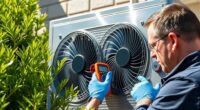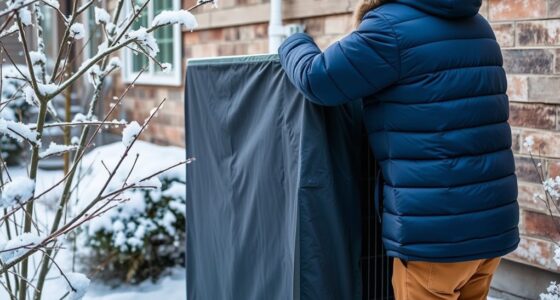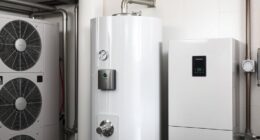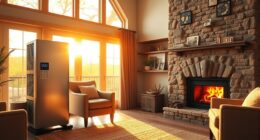For ideal performance, you should inspect and replace your heat pump filters every 1-3 months, especially during peak seasons. Clean the outdoor unit at least twice a year, in spring and fall, to prevent dirt buildup. Regular checks and maintenance help extend system life, reduce energy costs, and prevent costly repairs. Keeping a routine ensures your heat pump stays efficient year-round. Continue exploring to discover detailed tips on maintaining your system effectively.
Key Takeaways
- Inspect and replace filters every 1-3 months, especially during peak seasons, to ensure optimal airflow and indoor air quality.
- Clean the outdoor unit at least twice a year, ideally in spring and fall, to remove dirt, leaves, and debris.
- Schedule professional servicing annually to check refrigerant levels, electrical components, and system performance.
- Conduct regular inspections of the outdoor unit for debris buildup and damage, especially after storms or heavy winds.
- Adjust maintenance frequency based on usage, filter type, and local environment to maintain efficiency and prolong system lifespan.
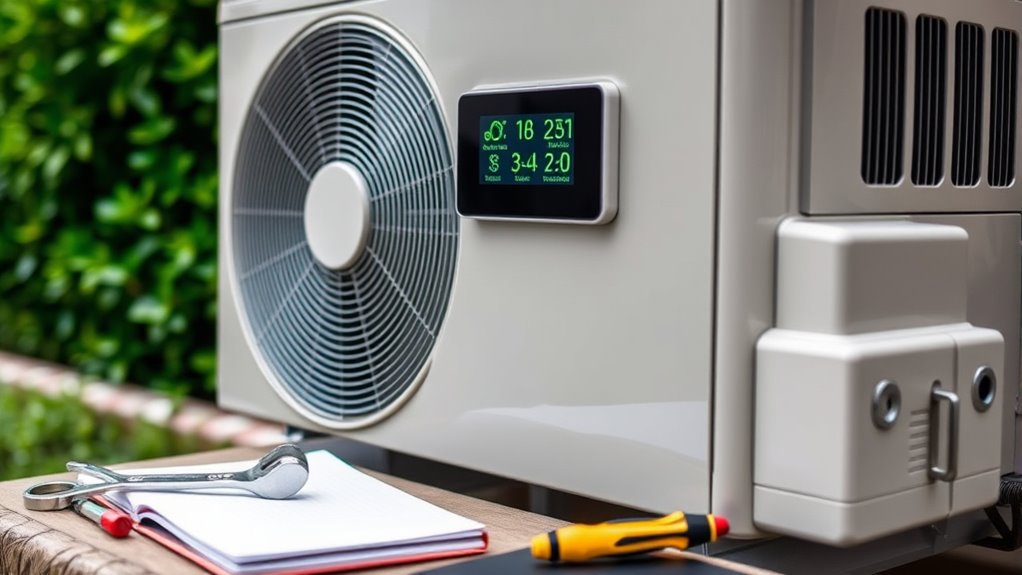
Have you ever wondered how to keep your equipment running smoothly and avoid costly breakdowns? Regular maintenance is key to ensuring your heat pump functions efficiently and lasts for years. One of the most important steps you can take is keeping up with a consistent maintenance schedule, which includes tasks like checking and replacing furnace filters and cleaning the outdoor unit. These simple actions can substantially improve performance and energy savings.
Furnace filters play a critical role in maintaining good indoor air quality and preventing dust, dirt, and debris from clogging your system. You should inspect your filters at least once a month, especially during peak heating or cooling seasons. If they look dirty or clogged, replace them immediately. Using high-quality filters and changing them regularly prevents strain on your heat pump, reduces energy consumption, and extends its lifespan. Neglecting this simple task can lead to reduced airflow and increased wear on your system, ultimately causing breakdowns that could have been avoided.
Check and replace filters monthly to maintain air quality and system efficiency.
In addition to indoor maintenance, outdoor unit cleaning is equally essential. Your heat pump’s outdoor unit is exposed to the elements, which means dirt, leaves, grass, and other debris can accumulate over time. Regularly inspecting and cleaning this part of your system helps maintain ideal airflow and heat transfer efficiency. To do this correctly, turn off the power to the unit, remove any debris around the fins, and gently rinse the outdoor coil with a garden hose. Avoid using harsh pressure washers or abrasive cleaners, as they can damage the fins. Keeping the outdoor unit clean not only improves efficiency but also prevents the system from overworking, which reduces wear and tear.
Furthermore, understanding the importance of regular maintenance can help extend the lifespan of your heat pump and ensure optimal operation year-round. How often should you perform these maintenance tasks? For furnace filters, aim to check them monthly and replace them every one to three months, depending on usage and filter type. Outdoor unit cleaning should be done at least twice a year, ideally during spring and fall, to prepare for the upcoming heating or cooling season. If you notice excessive dirt, leaves, or snow buildup, clean the outdoor unit sooner. Regular maintenance doesn’t have to be complicated, but sticking to a schedule guarantees your heat pump operates at peak performance, saving you money and avoiding unnecessary repairs.
Frequently Asked Questions
Can I Perform Heat Pump Maintenance Myself?
Yes, you can perform basic heat pump maintenance yourself with some DIY tips. Use maintenance tools like a soft brush, vacuum, and coil cleaner to keep your unit running efficiently. Make sure to turn off the power before inspecting or cleaning components. Regularly check and replace filters, clear debris around the outdoor unit, and inspect for any visible damage. However, for complex issues, it’s best to call a professional.
What Signs Indicate My Heat Pump Needs Servicing Sooner?
If your heat pump makes strange noises, blows weak air, or shows inconsistent heating or cooling, it’s time to schedule a service. Don’t fall for maintenance myths that you can ignore issues; DIY tips can help you spot problems early. If you notice ice buildup or higher energy bills, these signs mean your unit needs professional attention sooner. Regular check-ups keep your system running smoothly and efficiently.
How Does Outdoor Climate Affect Maintenance Frequency?
Imagine the changing seasons, with winter’s chill and summer’s heat, and your outdoor climate plays a big role in how often you should service your heat pump. Seasonal climate variations and humidity influence its performance, so in humid or extreme weather, you might need more frequent check-ups. Regular maintenance ensures your system runs efficiently year-round, preventing issues caused by climate fluctuations and keeping your home comfortable.
Are There Specific Parts That Require Regular Replacement?
Yes, you should regularly replace filters to keep your heat pump running effectively. Additionally, refrigerant checks are essential to guarantee proper cooling and heating performance. Over time, filters clog and refrigerant levels can drop, leading to higher energy use and potential damage. Make sure to inspect and replace filters every 1-3 months and schedule refrigerant checks annually. This routine helps maintain ideal operation and extends your heat pump’s lifespan.
What Are the Costs Associated With Professional Heat Pump Servicing?
Coincidence often makes you realize that professional heat pump servicing costs vary widely, typically ranging from $150 to $500 per visit. A thorough cost analysis reveals that service packages can offer savings, especially if scheduled regularly. You’ll want to compare what’s included—like system cleaning, filter replacement, and inspection—and choose a package that fits your budget and guarantees the best performance, preventing costly repairs down the line.
Conclusion
Neglecting your heat pump’s maintenance isn’t just a small mistake; it’s like leaving your entire home to fend for itself in a storm. Skipping those check-ups could turn your cozy sanctuary into a frozen wasteland or a scorching desert—faster than you can say “repair bill.” Keep up with regular servicing, and you’ll never have to face the chaos of sudden breakdowns or sky-high energy bills. Your comfort depends on it—don’t let neglect turn your home into a disaster zone.

